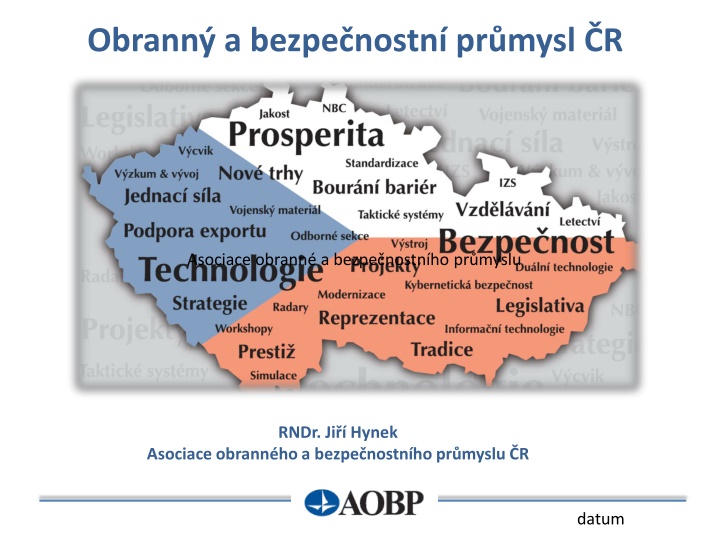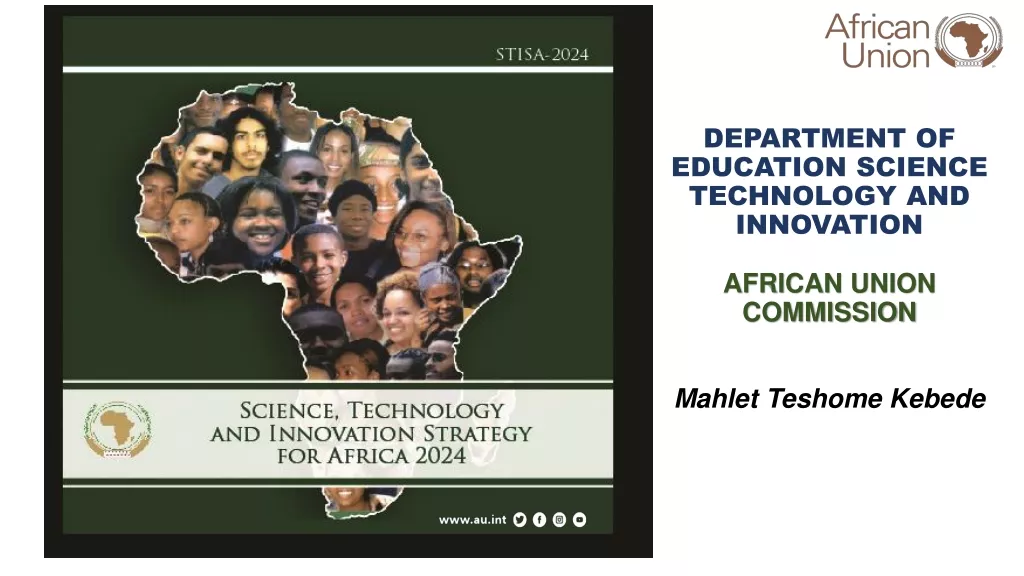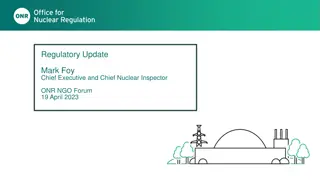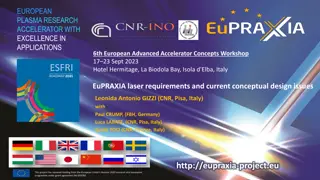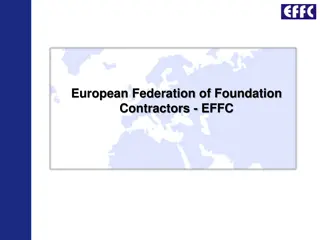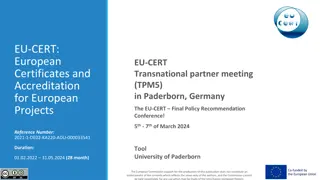European Defense Innovation Priorities
The European Defense Innovation Priorities encompass a range of initiatives focused on enhancing defense capabilities, including CBRN detection and medical countermeasures. These priorities emphasize the importance of preparation, protection, deployment, sustainability, information management, cyber defense, and engagement across various domains. The call for proposals underscores the need for enhanced CBRN capabilities to address potential threats effectively. The comprehensive set of capabilities aims to provide scientific and operational assessment for strategic decision-making and operational planning.
Download Presentation

Please find below an Image/Link to download the presentation.
The content on the website is provided AS IS for your information and personal use only. It may not be sold, licensed, or shared on other websites without obtaining consent from the author.If you encounter any issues during the download, it is possible that the publisher has removed the file from their server.
You are allowed to download the files provided on this website for personal or commercial use, subject to the condition that they are used lawfully. All files are the property of their respective owners.
The content on the website is provided AS IS for your information and personal use only. It may not be sold, licensed, or shared on other websites without obtaining consent from the author.
E N D
Presentation Transcript
Obrann a bezpenostn prmysl R Asociace obrann a bezpe nostn ho pr myslu RNDr. Ji Hynek Asociace obrann ho a bezpe nostn ho pr myslu R datum
Semin ke zdrojm EU Agenda: vod RNDr. Hynek Vzd l vac projekt AOBP Ing. Stejskalov PESCO Mgr. amonil EDIDP PhDr. Kope n EDF PhDr. Kope n Diskuze k praktick m ot zk m Ing. varc
Work Program EDIDP Kl ov dokument pro EDIDP stanov t mata 18.-19.12. zased n Pracovn ho v boru Leden 2019 p edpokl dan schv len Diskuze o p m m p id len prost edk (35- 40% pozice R, FR navrhla cca 70%)
EDIDP priority Preparation, protection, deployment and sustainability; Information management and superiority, command, control, communication, computers, intelligence, surveillance and reconnaissance (C4ISR), cyber defence and cyber security; Engagement and effectors; Cross-domain capabilities.
Chemical Biological Radiological Nuclear (CBRN) detection capabilities (call for proposals 2019) The resilience of EU and its preparedness to deal with CBRN threats needs to be enhanced, and there are significant cooperation opportunities on CBRN reconnaissance, decontamination, individual and collective protection as well as on training. A comprehensive set of CBRN capabilities must be capable of providing CBRN scientific and operational assessment and advice to commanders and their staffs during the planning and conduct of operations. The CDP analysis indicates the relevance of deploying dedicated Intelligence, Surveillance, Target Acquisition and Reconnaissance (ISTAR), exploitation and processing capabilities and specialised sensors for detection and early warning of potential CBRN threats to friendly populations and military forces. Early detection of CBRN threats can be supported by intelligence operations performed through web data mining in dark nets and deep web. Proposals are invited against the following topic: capabilities for CBRN risk assessment, detection, early warning and surveillance. 5 000 000
Chemical Biological Radiological Nuclear (CBRN) medical countermeasures (call for proposals 2020) Proposals are invited against the following topic(s): CBRN medical countermeasures, such as preventive and therapeutic immunotherapy and treatments for CBRN related injuries. Targeted type of action(s): studies, design and/or system prototyping, not excluding upstream or downstream activities. The indicative budget for this category is [EUR 10 000 000] inside which an indicative budget of [EUR X] has been earmarked to fund a study/studies. The equivalence between the CRBN counter-measures standardized process and Art. 6(1) of the EDIDP regulation shall be the following: (a) means feasibility studies; (b) means beginning of preclinical phase ; (c) means end of preclinical phase ; (d) means clinical tests phase I ; (e) means clinical test phase II or III ; (f) means temporary authorisation for use or marketing authorisation; (g) means pharmacovigilance.
Multipurpose unmanned ground system (call for proposals 2019) Proposals are invited against the following topic: multipurpose architecture for unmanned ground systems and solutions for systems integration and manned-unmanned teaming. Targeted type of action(s): system prototyping, not excluding upstream or downstream activities. The indicative budget for this category is [EUR 34 000 000].
Counter-UAS capabilities (call for proposals 2019) Proposals are invited against the following topic: capabilities to detect, classify, track, identify and/or counter UASs in defence scenarios. Targeted type of action(s): study, design and/or system prototyping, not excluding downstream activities. The indicative budget for this category is [EUR 15 000 000], inside which an indicative budget of [EUR X] has been earmarked to fund a study/studies. Attention will be paid to the civil and dual-use on-going initiatives at EC level to avoid any duplication.
Developing an appropriate spectrum of ISR air and space platforms and sensors (call for proposals 2019 and 2020) Proposals are invited against the following topic(s): MALE RPAS; Development of a low-observable tactical RPAS with the capability to provide near real time information and with modern self-protection; European Detect and Avoid (D&A) function based on new sensors and processing for RPAS integration into air-traffic management; Enduring High Altitude Platform Stations for military ISR and communication missions (including support to their integration into air-traffic management); Persistent earth observation from space with automated interpretation of data and information, including AI, cloud solutions and real time on board processing by sensors. Targeted type of action(s): design, not excluding upstream or downstream activities. The indicative budget for this category is [EUR 150 000 000]. Attention will be paid to the civil and dual-use on-going initiatives at EC level to avoid any duplication (especially with Copernicus). Remotely Piloted Air Systems
Combat communication and information sharing capability (call for proposals 2019) Proposals are invited against the following topic(s): Interoperable communication activities at tactical level compliant with ESSOR and SCA architecture software defined radio platforms; New generation of EU-MIDS terminals compatible with the US one; A Software Defined Network for military use including the development of products and technologies; Modular and adaptive tactical networks to control, change and manage network behaviour; Innovative future-oriented communication capabilities such as but not limited to quantum communications or high speed secure free space optical communication. Targeted type of action(s): design, prototyping and/or testing, not excluding upstream or downstream activities. The indicative budget for this category is [EUR 18 000 000]. Software Communication Architecture Multifunctional Information Distribution System
Cyber situational awareness and defence capabilities (call for proposals 2020) Proposals are invited against the following topic(s): cyber situational awareness and cyber response and defensive measures, including automated security and deployable capabilities, such as: A software suite enabling real-time cyber defence situational awareness for military decision-making; An easily deployable and interconnected cyber toolbox for military use. Targeted type of action(s): design and/or system prototyping, not excluding upstream or downstream activities. The indicative budget for this category is [EUR 20 000 000].
European Strategic Command and Control (ESC2) system (call for proposals 2019) Proposals are invited against the following topic: Strategic C2 and CIS capabilities and equipment needed for establishing a strategic C2 system. Targeted type of action(s): design, not excluding upstream and downstream activities. The indicative budget for this category is [EUR 20 000 000].
Upgrade of current and development of next generation ground-based precision strike capabilities anti-tank weapons (call for proposals 2019) Providing a high degree of accuracy while avoiding widespread collateral damage, and reducing exposure of friendly forces is a priority for EU MS armed forces. The CDP analysis identifies the need for the upgrade of current and development of next generation ground-based precision strike capabilities. Proposals are invited against the following topic: beyond line of sight (BLOS) anti-tank capabilities. Targeted type of action(s): testing, not excluding upstream or downstream activities. The indicative budget for this category is [EUR 7 500 000].
Upgrade of current and development of next generation ground-based precision strike capabilities direct and indirect fire (call for proposals 2020) Providing a high degree of accuracy while avoiding widespread collateral damage, and reducing exposure of friendly forces is a priority for EU MS armed forces. The CDP analysis identifies the need for the upgrade of current and development of next generation ground-based precision strike capabilities, including ammunition and fire control systems. Proposals are invited against the following topic: the development of direct and indirect fire support capabilities, such as: A platform for long range indirect fire support capabilities; Programmable ammunition. Targeted type of action(s): design and/or prototyping, not excluding upstream or downstream activities. The indicative budget for this category is [EUR 7 500 000].
Ground combat capabilities (call for proposals 2020) Proposals are invited against the following topic(s): development of next generation and upgrade of current armoured platforms, including those able to operate in extreme climates and geographical environments. Targeted type of action(s): study, not excluding downstream activities. The indicative budget for this category is [EUR 7 000 000].
Defence technologies supported by Artificial Intelligence (call for proposals 2020) The following areas outlined in CDP should be prioritized: Support decision-making tools in command and control at all levels, including the use of predictive algorithms to anticipate threats/trends through analysis of big data and neural networks; Improve intelligence gathering and processing to provide common operational picture and situational awareness; Support recurrent activities such as STRATCOM, logistics planning, airspace management, energy management of platforms, and analysis of lessons identified in operational context; Develop the desired level of autonomy of unmanned systems with autonomous and (automated) Guidance, Navigation and Control for mobility and with autonomous decision making for responsiveness in order to operate in highly dynamic, contested and congested environments Proposals are invited against the following topic(s): defence capabilities supported by Artificial Intelligence. Targeted type of action(s): design and/or system prototyping, not excluding upstream or downstream activities. The indicative budget for this category is [EUR 5 000 000].
Category for SMEs Innovative and future-oriented defence solutions (calls for proposals 2019 and 2020) Proposals are invited against the following topic(s): Innovative defence products, solutions and technologies, including those that can create a disruptive effect and improve readiness, deployability and sustainability of EU forces in all spectrum of tasks and missions, for example in terms of operations, equipment, basing, energy solutions, new surveillance systems, such as: Global cyber protection solutions for the future security and defense systems (C2, Logistic, embedded combat system, distributed simulation); Portable bacteriological and chemical future detection systems; Future soldier CRBN protection equipment and integration; End to end and ITAR free solutions for Artificial Intelligence in defense & security key strategic issues; Command and control systems designated for individual soldier-squad up to brigade Cmd, post logistic information system for maintenance, transport, medical, POL, management;
Pokraovn SMEs Armoured medium and light vehicle; Tactical logistic trucks; Protected, cooled and connected shelter solutions for fixed and mobile command post for EU operations; Future effective and instantaneous protection capacity to civil population, military and their equipment; Mobility support deployable solution for amphibious and airmobile (helicopter) operations; Innovative battery for future infantry portable system (radio set, optronic ) and for weapon system (missile) ignition; Integrated management system for assets and services required in emergency situations in the framework of UE military operations, in order to increase sustainability of EU forces The indicative budget for this category is [EUR 16 000 000] ([EUR 6 000 000] in 2019, [EUR 10 000 000] in 2020).
Projects to be selected for direct award TBD Article 15(1) on the Evaluation and award procedure of the EDIDP regulation provides that in certain duly justified and exceptional circumstances, Union funding may also be granted in accordance with Article 190 of Delegated Regulation (EU) No 1268/2012. Article 190 of Delegated Regulation (EU) No 1268/2012 provides that Grants may be awarded without a call for proposals only for specific cases, and this would mean that with the adoption of the Work Programme, project(s) are selected. Three projects have been proposed by MS for direct award: 1. MALE RPAS 2. ESSOR 3. Tiger upgrade
Financovn Activity Baseline funding rate Up to 90% of eligible costs Studies (such as feasibility studies) Up to 65% of eligible costs Design Up to 20% of eligible costs System prototyping Up to 65% of eligible costs Testing Qualification, certification, development of technologies or assets increasing efficiency across the life cycle Up to 65% of eligible costs
Zven financovn Condition Increase in funding rate Action developed in the context of Permanent Structured Cooperation (PESCO) + 10% EU-established SME participation ???????? ????? ?? ?? ??? ????? ???????? ????? > 10% EU-established Mid-cap participation + 10% ???????? ????? ?? ?? ?????? ????? ???????? ????? > 15%
Indirect eligible costs Indirect eligible costs shall be determined by applying a flat rate of 25% of the total direct eligible costs, excluding direct eligible costs for subcontracting. The award of the grants is expected for 2019 and 2020 and the duration of the actions is expected to be no longer than 48 months.
Pleitosti pro SMEs Areas which could attract support from the EDIDP include: carrying out feasibility studies; product design and testing; development of prototype equipment and technology; and qualification and certification. Funding will be made available through co-financing. For prototyping, 20 % of costs will be covered by the programme, while feasibility studies, design, testing, qualification and certification could attract up to 100 %. There is also a 25 % flat rate contribution for indirect costs.
PADR The budget for the PADR related actions is split in three years as follows: 25 M in 2017 (already committed, first projects starting); 40 M in 2018 (approved and calls for proposals closed); 25 M in 2019 (to be confirmed and approved). PADR 2018 Information Day & Brokerage Event The event was held on 12 April in Brussels. Proposal Submission Proposals must be submitted electronically using the electronic submission system of the Participant Portal. Access to the electronic submission system is available after selecting a topic and a type of action of a call. Proposals must be created and submitted by a representative/contact person of the coordinating organisation. The electronic submission system is an online wizard that guides you step-by-step through the preparation of your proposal. The proposal itself consists of 2 main parts: administrative forms (structured information of the basic administrative data, declarations of partners, organisations and contact persons, etc.) and the technical annex, which is the detailed description of the planned research and innovation project outlining work packages, costs, etc. Further mandatory or optional annexes (e.g. supporting documents) can be required by the call and the given topic, as shown in the submission system.
Podrobnosti o lenech AOBP - www.aobp.cz - lenov AOBP Ke sta en katalog AOBP 25/20
Kontakt info@aobp.cz AOBP Washingtonova 25 110 00 Praha 1 www.aobp.cz 26/20
